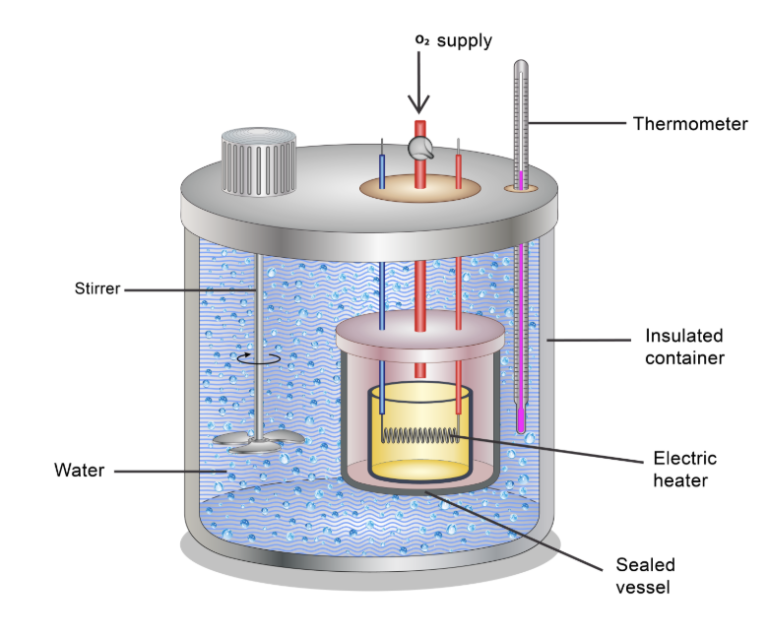What Is a Calorie?
One calorie* is the amount of energy required to raise the temperature of one liter of water by one degree Celsius.
*This is technically known as a kilocalorie (kcal), though in nutrition we often just say “calorie” for short.
A calorie is not a thing you can see, touch, or weigh — it’s a human-invented unit of measurement for energy.
The calorie as a unit of energy was first introduced in the early 1800s during lectures on heat engines in France. At the time, it had nothing to do with food or the human body — it was purely a measure of thermal energy used in physics and engineering.
 In the 1880s, scientists devised a simple, low-tech device called a Bomb Calorimeter. Any organic material can be placed in the sealed chamber, which is surrounded by water. Then the material is combusted with oxygen, and the resulting heat raises the temperature of the surrounding water. This tells us how much energy, as heat, the material was able to produce when combusted.
In the 1880s, scientists devised a simple, low-tech device called a Bomb Calorimeter. Any organic material can be placed in the sealed chamber, which is surrounded by water. Then the material is combusted with oxygen, and the resulting heat raises the temperature of the surrounding water. This tells us how much energy, as heat, the material was able to produce when combusted.
The Bomb Calorimeter marked a significant leap in the ability to accurately (and simply) measure the energy content of materials. You may have used one in your high school science class to measure the calorie content of a peanut, a piece of wood, or a fuel like gasoline.
By the late 19th century, “the calorie” had made its way into the study of human physiology, and scientists began applying it to food and metabolism. When we talk about “calories” in the context of nutrition, it’s important to note we’re using a relatively modern concept and, in the scope of human evolution, is brand new. The Bomb Calorimeter quickly became a foundational tool in nutrition science because it allowed scientists to quantify the energy content of different foods by burning them and measuring the heat output.
Remember, a calorie has no physical properties. It’s a unit of measurement we use to quantify energy — helpful in some ways, but not an explanation of how the body uses food. This is important to understand: the human body has been managing energy balance for hundreds of thousands of years, long before we invented a way to measure that energy with a number.
Energy Balance
The basic definition of energy balance is:
- If you gain body fat (which is “stored energy”), you consumed more calories than you expended.
- If you lost body fat, you consumed fewer calories than you expended.
One pound of human (or other animal) fat can be placed in a bomb calorimeter, where it will produce about 3,500 Cal of energy. So, if a person gained one pound of fat, they were in a positive energy balance of 3,500 Cal; if a person lost one pound of fat, they were in a negative energy balance of 3,500 Cal.
These are facts, as a function of the definition of the terms. However, these statements tell us nothing about causation and what circumstances create positive or negative energy balance.
A definition tells us nothing about causality.
The CICO Model is Born
During the mid-20th century, a strange new public health crisis emerged. For the first time in human history, people in Western, industrialized societies were gaining excess body fat and becoming obese at ever-increasing, alarming rates. While the field of nutrition up to that point had been focused on identifying individual nutrients and solving deficiency diseases like scurvy and rickets, it now turned its attention to the problem of obesity.
Given that 1 pound of body fat has a caloric value of 3500 Cal, it follows logically that losing excess body fat must be a simple calculation of creating a caloric deficit. This is known as the Calories In, Calories Out (CICO) model. Restricting food intake, increasing energy expenditure, or a combo of both, to the tune of 500 Cal per day should produce a linear and sustained weight loss of 1 pound of body fat per week. 500 x 7 = 3,500 after all. Simple math, right?
Unfortunately, real-world results don’t match this prediction. Despite being tested on millions of people, no study has ever shown that consistently eating 500 fewer calories daily results in exactly 1 pound of fat loss per week. If a model fails to achieve its predicted outcome, it is not a good model.
Sometimes people lose more, sometimes less, and sometimes nothing at all.
The big question is WHY?
Because the CICO model makes a fundamental mathematical assumptive error: calories in and calories out are not independent variables; they are dependent variables, meaning manipulating one affects the other.
Calories Are Inputs — But the Body Is Not a Math Equation
Let’s do a quick thought experiment. Imagine you’re invited to a big dinner party tonight and want to show up hungry. What would you do? Most people would say something like “skip lunch” or “work out.” To make yourself really hungry, the strategies fall into two buckets: eat less or move more. And yet this is the same advice typically given for weight loss. But in this case, those strategies aren’t about losing weight — they’re about stimulating hunger. In other words, reducing “calories in” or increasing “calories out” increases appetite. And that’s a problem if you’re trying to maintain a calorie deficit over time. Any strategy that relies on withstanding hunger through willpower alone will not work long-term.
The human body is designed to maintain a state of balance, known as homeostasis. The fuel that generates the energy needed to sustain life comes from one of two places:
- The food you ate today
- The food you ate on a different day that was stored for later
When current food intake does not match energy needs, the body mobilizes energy primarily from the fat tissue, somewhat from glycogen in the liver and muscles, and only rarely from the amino acids contained in the body’s proteins.
When you eat less for prolonged periods of time (approximately two weeks or more), the body uses some stored energy, but then begins to compensate for the lower food intake by reducing energy expenditure to promote survival.
The body can reduce “calories out” by:
- Lowering body temperature
- Reducing brain and other organ function
- Getting rid of metabolically active tissue (muscle)
- Decreasing energy levels and lowering general daily movement
- Turning off reproduction (loss of libido in men or women, loss of menstrual cycle in women)
- Lowering immune function
This makes caloric restriction-based weight loss difficult or impossible to sustain, and it explains why so many people do not see long-term results on a simple CICO plan.
The Measurement Problem
Even if the calorie model worked perfectly in theory, it fails in practice because accurately tracking calorie intake and expenditure is nearly impossible.
Food labels and restaurant menus can be off by 20-25%, and even food prepared at home has a huge margin of error. Consider the following:
- Was your chicken breast injected with a saline solution?
- Was that banana green or overripe?
- Did all the olive oil make it from the pan to your plate?
On the expenditure side, the only truly accurate method for measuring energy burn is to live inside a sealed metabolic chamber — not exactly practical.
The calorie model also asserts that a conscious daily surplus or deficit of just 100 calories (roughly a handful of almonds) would result in 10 pounds of fat gain or loss in a year — an overtly ridiculous assertion. Many people maintain stable weights for years without such extreme precision. How? Because the body is actively regulating energy balance, not through calorie math but through complex biological systems.
The Body Doesn’t Count Calories
The human body does not have receptors for calories. It doesn’t “see” an energy number. Instead, the body senses the components of food (amino acids, fats, starches, sugars, vitamins, and minerals) and the environmental context (light/dark, hot/cold). Sensing these cues, the body decides whether now is a good time to store or use energy, and responds accordingly with the appropriate hormones that drive these processes. This elegant dance is highly conserved through millions of years of evolution to promote survival.
In Part 2 of this series, we’ll begin our deep dive into the macronutrients.
About the Author
 Jocelyn Rylee (CF-L4) and her husband David founded CrossFit BRIO in 2008, starting in a modest 1500 sq ft space and focusing on personal training. Her dedication to excellence has also earned her a position on CrossFit LLC’s Level 1 Seminar Staff, a role that allows her to share her passion and expertise with aspiring coaches. Jocelyn holds specialties in Endurance, Gymnastics, Competition, and Weightlifting and is also a certified Strength and Conditioning Specialist through the NSCA. As a Level 2 Olympic Weightlifting Coach and a Level 3 referee, she has been deeply involved in the sport, even serving as a board member of the Saskatchewan Weightlifting Association for five years. Her achievements include being Saskatchewan’s top-ranked female Olympic Weightlifter from 2012 to 2015, during which she held provincial records in the Snatch, Clean & Jerk, and Total in her weight class. With an MS in Human Nutrition, Jocelyn loves sharing her knowledge on nutrition and performance through her blog and Instagram as “The Keto Athlete,” where she delves into the science of nutrition and its impact on athletic performance.
Jocelyn Rylee (CF-L4) and her husband David founded CrossFit BRIO in 2008, starting in a modest 1500 sq ft space and focusing on personal training. Her dedication to excellence has also earned her a position on CrossFit LLC’s Level 1 Seminar Staff, a role that allows her to share her passion and expertise with aspiring coaches. Jocelyn holds specialties in Endurance, Gymnastics, Competition, and Weightlifting and is also a certified Strength and Conditioning Specialist through the NSCA. As a Level 2 Olympic Weightlifting Coach and a Level 3 referee, she has been deeply involved in the sport, even serving as a board member of the Saskatchewan Weightlifting Association for five years. Her achievements include being Saskatchewan’s top-ranked female Olympic Weightlifter from 2012 to 2015, during which she held provincial records in the Snatch, Clean & Jerk, and Total in her weight class. With an MS in Human Nutrition, Jocelyn loves sharing her knowledge on nutrition and performance through her blog and Instagram as “The Keto Athlete,” where she delves into the science of nutrition and its impact on athletic performance.